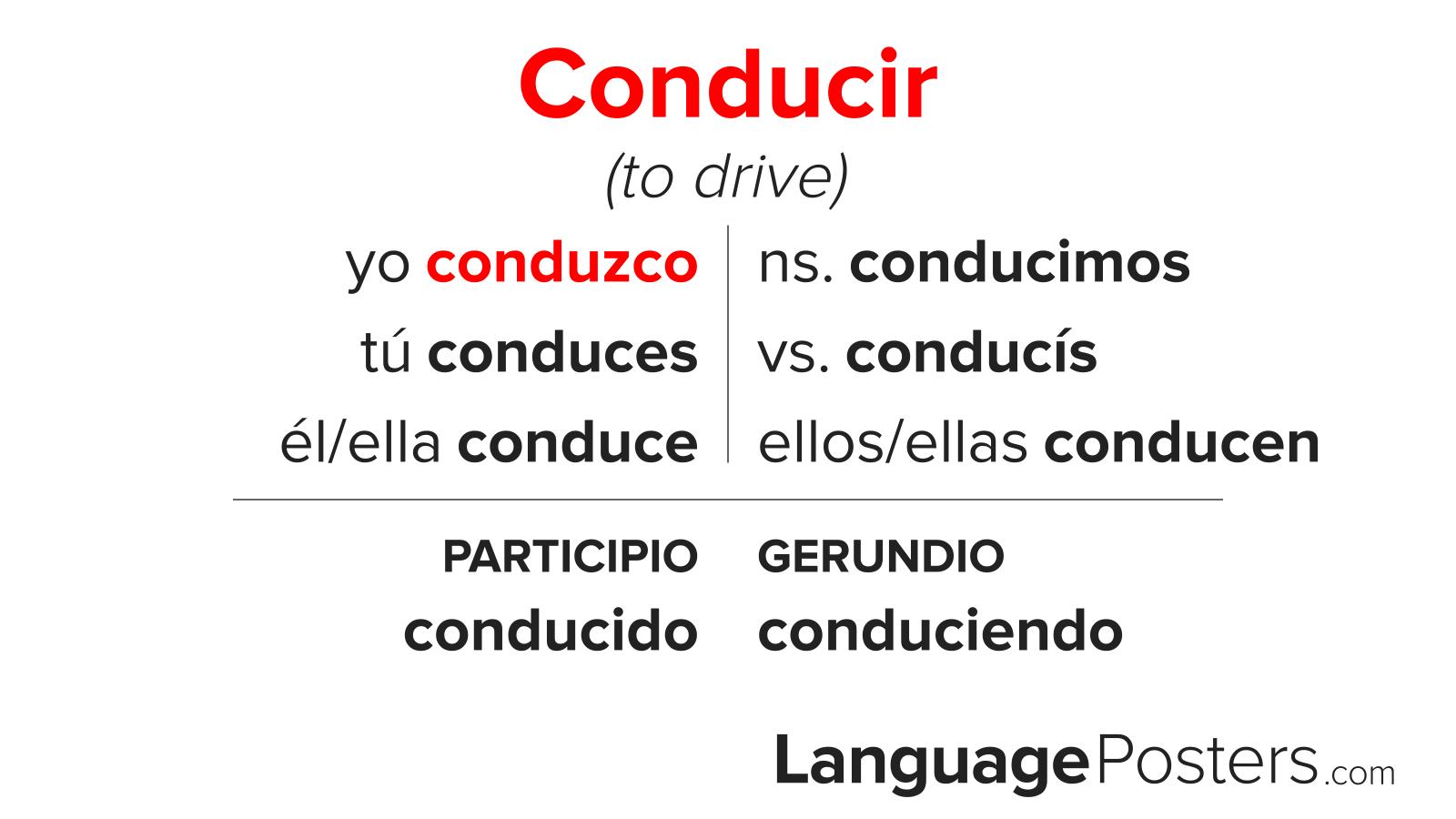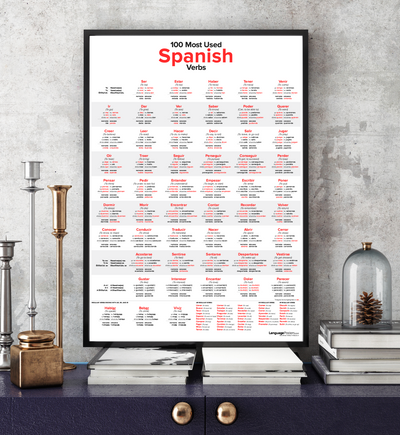Spanish Verbs
Conducir Conjugation

Conducir is a Spanish irregular IR verb meaning "to drive". Irregular verbs are verbs which do not follow the standard conjugation patterns of Spanish regular verbs.
Present Tense
Past Tenses
- Conducir Past Tense
- Conducir Preterite
- Conducir Imperfect
- Conducir Present Perfect
- Conducir Past Perfect
Future Tenses
Subjunctive Tenses
Further Reading
100 Most Used Spanish Verbs Poster w/ Study Guide
A selection of the most used irregular and regular Spanish verb conjugations. A must have for anyone who wants to learn Spanish!
Conducir Conjugation
| Pronoun | Conjugation | Translation |
|---|---|---|
| Yo | conduzco | I drive |
| Tú | conduces | You drive |
| Él/Ella/ |
conduce | He/She drives |
| Nosotros | conducimos | We drive |
| Vosotros | conducís | You (plural) drive |
| Ellos/ |
conducen | They drive |
* Irregular forms are highlighted in red
Conducir Participio
The Participio or Past Participle of Conducir is conducido. This is used to form the Conducir Present Perfect and the Conducir Past Perfect.
Conducir Gerundio
The Gerundio or Present Participle of Conducir is conduciendo. This is used to form the Conducir Present Continuous.
Conducir Present Continuous
The Present Continuous (presente progresivo or presente continuo) is used to describe actions that are happening right now or around now. To form the present continuous tense, combine the Estar conjugation with the Conducir Gerundio (or Present Participle).
Example: Él está siendo muy egoísta últimamente. (He is being very selfish lately.)
| Pronoun | Conjugation | Translation |
|---|---|---|
| Yo | estoy conduciendo | I am driving |
| Tú | estás conduciendo | You are driving |
| Él/Ella/ |
está conduciendo | He/She is driving |
| Nosotros | estamos conduciendo | We are driving |
| Vosotros | estáis conduciendo | You (plural) are driving |
| Ellos/ |
están conduciendo | They are driving |
* Irregular forms are highlighted in red
Back to topConducir Past Tense
Spanish has several past tenses, each serving a specific purpose to express actions in the past.
Additionally, the use of Spanish past tenses can vary significantly across regions due to cultural and linguistic differences.
These are some of the most commonly used Spanish past tenses:
Conducir Preterite
The Preterite Tense (Pretérito or Indefinido) is used for completed actions in the past that have a clear beginning or end.
Example: Ayer comí pizza. (Yesterday, I ate pizza).
| Pronoun | Conjugation | Translation |
|---|---|---|
| Yo | conduje | I drove |
| Tú | condujiste | You drove |
| Él/Ella/ |
condujo | He/She drove |
| Nosotros | condujimos | We drove |
| Vosotros | condujisteis | You (plural) drove |
| Ellos/ |
condujeron | They drove |
* Irregular forms are highlighted in red
Back to topConducir Imperfect
The Imperfect Tense (Imperfecto) describes ongoing, habitual, or background actions in the past, often without a defined start or end.
Example: Cuando era niño, jugaba fútbol todos los días. (When I was a child, I used to play soccer every day).
| Pronoun | Conjugation | Translation |
|---|---|---|
| Yo | conducía | I used to drive |
| Tú | conducías | You used to drive |
| Él/Ella/ |
conducía | He/She used to drive |
| Nosotros | conducíamos | We used to drive |
| Vosotros | conducíais | You (plural) used to drive |
| Ellos/ |
conducían | They used to drive |
* Irregular forms are highlighted in red
Back to topConducir Present Perfect
The Present Perfect Tense (Presente Perfecto) is used to describe actions that have been completed recently or have relevance to the present moment. The Present Perfect Tense is formed by combining the Present Tense of the auxiliary verb Haber Conjugation with the Conducir Participio.
Example: He leído ese libro. (I have read that book).
| Pronoun | Conjugation | Translation |
|---|---|---|
| Yo | he conducido | I have driven |
| Tú | has conducido | You have driven |
| Él/Ella/ |
ha conducido | He/She has driven |
| Nosotros | hemos conducido | We have driven |
| Vosotros | habéis conducido | You (plural) have driven |
| Ellos/ |
han conducido | They have driven |
* Irregular forms are highlighted in red
Back to topConducir Past Perfect
The Past Perfect Tense (Pluscuamperfecto) refers to actions completed before another action in the past. The Past Perfect Tense is formed by combining the Imperfect Tense of the auxiliary verb Haber Conjugation with the Conducir Participio.
Example: Había comido antes de salir. (I had eaten before leaving).
| Pronoun | Conjugation | Translation |
|---|---|---|
| Yo | había conducido | I had driven |
| Tú | habías conducido | You had driven |
| Él/Ella/ |
había conducido | He/She had driven |
| Nosotros | habíamos conducido | We had driven |
| Vosotros | habíais conducido | You (plural) had driven |
| Ellos/ |
habían conducido | They had driven |
* Irregular forms are highlighted in red
Back to topConducir Future Tense
The Future Tense (Futuro) is used to describe actions or events that will happen in the future. It often expresses certainty or plans about what is yet to come.
Example: Mañana comeré pizza. (Tomorrow, I will eat pizza).
| Pronoun | Conjugation | Translation |
|---|---|---|
| Yo | conduciré | I will drive |
| Tú | conducirás | You will drive |
| Él/Ella/ |
conducirá | He/She will drive |
| Nosotros | conduciremos | We will drive |
| Vosotros | conduciréis | You (plural) will drive |
| Ellos/ |
conducirán | They will drive |
* Irregular forms are highlighted in red
Back to topConducir Conditional Tense
The Conditional Tense (Condicional) is used to express hypothetical situations, polite requests, or actions that depend on other conditions. It is often used in combination with the Future Tense.
Example: Me gustaría un café, por favor.(I would like a coffee, please).
| Pronoun | Conjugation | Translation |
|---|---|---|
| Yo | conduciría | I would drive |
| Tú | conducirías | You would drive |
| Él/Ella/ |
conduciría | He/She would drive |
| Nosotros | conduciríamos | We would drive |
| Vosotros | conduciríais | You (plural) would drive |
| Ellos/ |
conducirían | They would drive |
* Irregular forms are highlighted in red
Back to topConducir Subjunctive
The Subjunctive Tense (Subjuntivo) is used to express doubt, uncertainty, desire, or emotion. It is often used in dependent clauses introduced by specific conjunctions or verbs.
Example: Espero que seas feliz. (I hope you are happy).
| Pronoun | Conjugation | Translation |
|---|---|---|
| Yo | conduzca | I drive |
| Tú | conduzcas | You drive |
| Él/Ella/ |
conduzca | He/She drives |
| Nosotros | conduzcamos | We drive |
| Vosotros | conduzcáis | You (plural) drive |
| Ellos/ |
conduzcan | They drive |
* Irregular forms are highlighted in red
Back to topSpanish Regular Verbs
A verb is called a regular verb when its conjugation follows a consistent and predictable pattern. In contrast, a verb that does not follow these standard patterns is called an irregular verb. In Spanish, the three regular conjugation patterns are based on the verb endings: -AR, -ER, and -IR.

Spanish Conjugation Chart
Looking for more Spanish verbs like Conducir? Check out our Spanish Conjugation Chart, the 100 Most Used Spanish Verbs Poster!
Back to top

